-
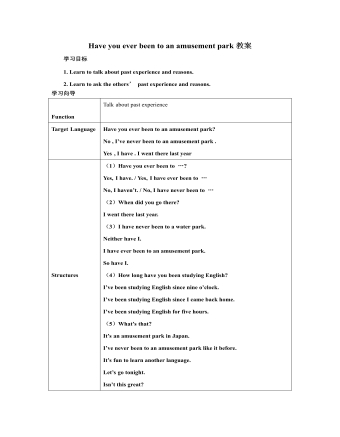
人教版新目标初中英语八年级下册Have you ever been to an amusement park教案
(1)Have you ever been to …? Yes, I have. / Yes, I have ever been to …No, I haven’t. / No, I have never been to …(2)When did you go there? I went there last year. (3)I have never been to a water park. Neither have I. I have ever been to an amusement park. So have I. (4)How long have you been studying English? I’ve been studying English since nine o’clock. I’ve been studying English since I came back home. I’ve been studying English for five hours. (5)What’s that? It’s an amusement park in Japan. I’ve never been to an amusement park like it before. It’s fun to learn another language. Let’s go tonight. Isn’t this great?space museum, amusement park, water park, South America, Peru, Holland, European culture, tour guide, flight attendant, musical instrument, more than, be from, get to, take lessons, neither, discover, graduate, change
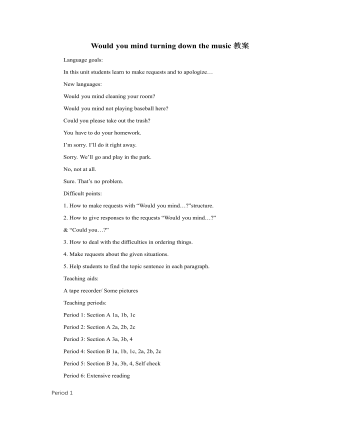
人教版新目标初中英语八年级下册Would you mind turning down the music教案
Step 4. Group work (4)1. Ask a pair of students to read the dialogue. Say, This activity provides speaking, listening and writing practice using the target language.2. Ask students to complete the work in groups.3. Check the answers with the whole class. 4. Explain some of the language points. Step 5. Word review (Self check 1)1. Ask students to read the words and the phrases given. 2. Fill in the blanks with proper forms of these words to complete the sentences. 3. Check the answers with the whole class. Homework:Do activity 2 on page 57 after class. Period 6Teaching aims: 1. Teach vocabulary words and the useful expressions. 2. Enable the students to learn etiquette in different culture. 3. Help the students learn how to behave politely in public places and in daily life. Teaching procedures:Step 1. RevisionHelp students to review the function of making requests through a free talk. Then lead them to the topic of etiquette. Explain the meaning of etiquette. Or, ask students to look it up in the dictionary. Step 2. Pre-reading (Section 1)1. Ask students to read the picture and make a list with their partner about how many rules of etiquette can be seen being broken.
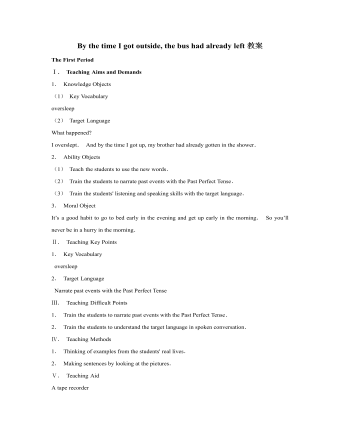
人教版新目标初中英语九年级下册By the time I got outside, the bus had already left教案
Ⅰ. Teaching Aims and Demands1. Knowledge Objects(1) Key Vocabularyoversleep(2) Target LanguageWhat happened?I overslept. And by the time I got up, my brother had already gotten in the shower.2. Ability Objects(1) Teach the students to use the new words.(2) Train the students to narrate past events with the Past Perfect Tense.(3) Train the students' listening and speaking skills with the target language.3. Moral ObjectIt’s a good habit to go to bed early in the evening and get up early in the morning. So you’ll never be in a hurry in the morning.Ⅱ. Teaching Key Points1. Key Vocabularyoversleep2. Target LanguageNarrate past events with the Past Perfect TenseⅢ. Teaching Difficult Points1. Train the students to narrate past events with the Past Perfect Tense.2. Train the students to understand the target language in spoken conversation.Ⅳ. Teaching Methods1. Thinking of examples from the students' real lives.2. Making sentences by looking at the pictures.Ⅴ. Teaching AidA tape recorderⅥ. Teaching ProceduresStep I Revision1. Revise the language points in Unit 8.Ask some questions like this: What volunteer work would you like to do?Help the students to answer, I’d like to…/I love to…/I hope to2. Practice the dialogue in Activity 3c on page 62 again. Get students to role play the similar dialogues with the following.
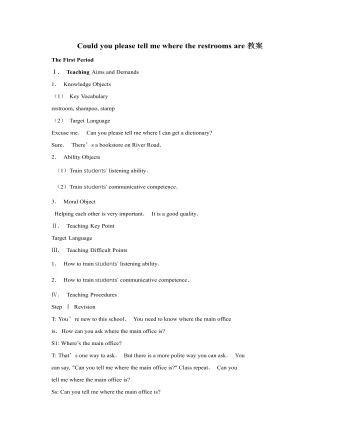
人教版新目标初中英语九年级下册Could you please tell me where the restrooms are教案
Step Ⅰ RevisionCheck homework. Ask a few students to read the article in 3a.Then ask a few students to read their guides.Step Ⅱ Part 1Look at the words in the box. Ask a student to read them. Make sure the students understand the meaning of the words. You are to fill in the blanks with the words. In some cases, students may need to use another form of the word, for example adjusting for tense or subject/ verb agreement.Ask students to fill in the blanks on their own.Check the answers. Step ⅢPart 2Go through the instructions with the class.Look at the example with the students.Ask students what the answer would be.Ask a student to read the question and answer it.Excuse me, could you tell me where the bank is, please?The bank is across the street from the shopping malt.Get students to complete the work in pairs.Check the answers. Ask a few students to read their questions.Step Ⅳ Just for Fun!Ask all the students to read the conversation. Ask: What is funny about this cartoon? Help students to explain. A Martian is a person from the planet Mars.There is no such thing as Martian food on Earth, and the clerk looks silly because he is trying to think of where there is a Martian restaurant.Invite some pairs of students to present this conversation to the rest of the class.Step Ⅴ Summary and HomeworkIn this class, we’ve done much writing practice using the key vocabulary words and the target language presented in this unit. After class, please finish the questions in 2 in your exercise books. Then finish the exercises on pages 47~48 of the workbook as well.The Seventh Period Ⅰ Teaching Aims and Demands1. Knowledge Objects(1) Key Vocabularyimage, adventure, jealousy, hero, crime, journey, brave, no longer, show interest in, take it easy, become interested in, plain looks(2)Text:Grown-ups like cartoons, too.2. Ability Objects(1) Fast-reading to get a general idea of the text.(2) Careful-reading to get the detailed information in the text.
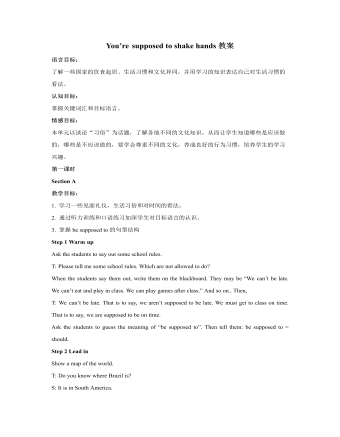
人教版新目标初中英语九年级下册You’re supposed to shake hands教案
教学目标:1. 掌握本单元一些重点词汇的写法和用法。2. 学会自如谈论餐桌礼仪。Step 1 RevisionAsk some students to retell the customs at the table in France in the passage in 3a.Step 2 Self checkPart 1. Fill in each bland with the correct word given. Students do the exercises by themselves at first. Then check the answers. Ask the students to comprehend the sentences and help them point out uses of some words, like “arrive (at / in) sw., spend time / money on sth , spend time / money (in) doing sth.”Part 2. Read about Fan Ling’s experience in a western restaurant. Understand the passage. Point out some key points in the passage.1. be / get used to doing sth. 习惯做某事2. begin with = start with 以….开头3. crowd v. 挤满,塞满 the crowd 人群 crowded adj. 拥挤的Then students discuss about how she would solve her problem. Ask some to share their stories with others.Part 3. Complete the crossword by looking at the sentences on the left. Then check the answers.
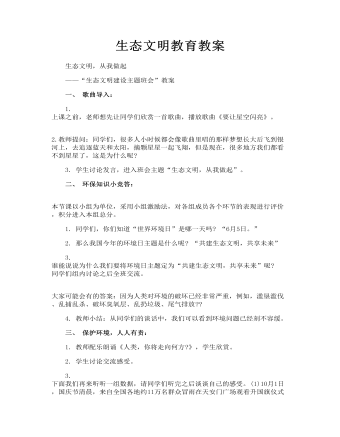
生态文明教育教案
二、 环保知识小竞答: 本节课以小组为单位,采用小组激励法,对各组成员各个环节的表现进行评价,积分进入本组总分。 1. 同学们,你们知道“世界环境日”是哪一天吗? “6月5日。” 2. 那么我国今年的环境日主题是什么呢? “共建生态文明,共享未来” 3. 谁能说说为什么我们要将环境日主题定为“共建生态文明,共享未来”呢? 同学们组内讨论之后全班交流。 大家可能会有的答案:因为人类对环境的破坏已经非常严重,例如,滥垦滥伐、乱捕乱杀、破坏臭氧层、乱扔垃圾、尾气排放?? 4. 教师小结:从同学们的谈话中,我们可以看到环境问题已经刻不容缓。
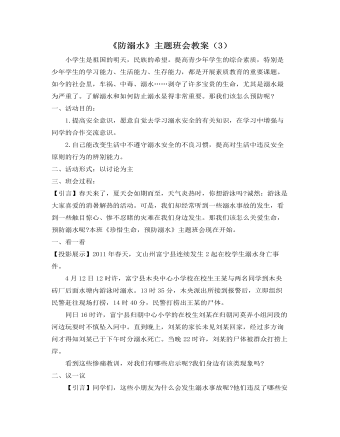
《防溺水》主题班会教案(3)
三、班会过程: 【引言】春天来了,夏天会如期而至,天气炎热时,你想游泳吗?诚然:游泳是大家喜爱的消暑解热的活动。可是,我们却经常听到一些溺水事故的发生,看到一些触目惊心、惨不忍睹的灾难在我们身边发生。那我们该怎么关爱生命,预防溺水呢?本班《珍惜生命,预防溺水》主题班会现在开始。 一、看一看 【投影展示】2011年春天,文山州富宁县连续发生2起在校学生溺水身亡事件。4月12日12时许,富宁县木央中心小学校在校生王某与两名同学到木央砖厂后面水塘内游泳时溺水。13时35分,木央派出所接到报警后,立即组织民警赶往现场打捞,14时40分,民警打捞出王某的尸体。同日16时许,富宁县归朝中心小学的在校生刘某在归朝河莫弄小组河段的河边玩耍时不慎坠入河中。直到晚上,刘某的家长未见刘某回家,经过多方询问才得知刘某已于下午时分溺水死亡。当晚22时许,刘某的尸体被群众打捞上岸。看到这些惨痛教训,对我们有哪些启示呢?我们身边有该类现象吗?
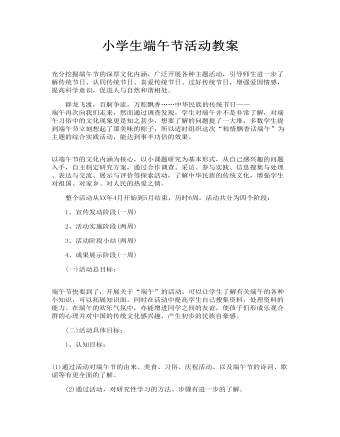
小学生端午节活动教案
群龙飞渡,百舸争流,万粽飘香……中华民族的传统节日——端午再次向我们走来,然而通过调查发现,学生对端午并不是非常了解,对端午习俗中的文化现象更是知之甚少,想要了解的问题提了一大堆,多数学生提到端午节立刻想起了那美味的粽子,所以适时组织这次“粽情飘香话端午”为主题的综合实践活动,能达到事半功倍的效果。 以端午节的文化内涵为核心,以小课题研究为基本形式,从自己感兴趣的问题入手,自主制定研究方案,通过合作调查、采访、参与实践、信息搜集与处理、表达与交流、展示与评价等探索活动,了解中华民族的传统文化,增强学生对祖国、对家乡、对人民的热爱之情。
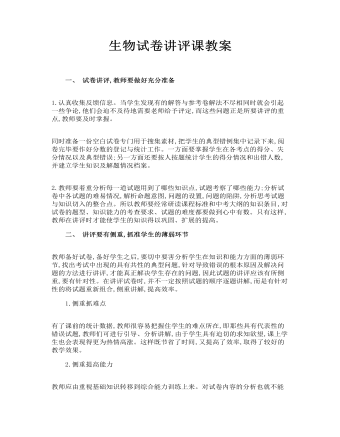
生物试卷讲评课教案
二、 讲评要有侧重,抓准学生的薄弱环节 教师备好试卷,备好学生之后,要切中要害分析学生在知识和能力方面的薄弱环节,找出考试中出现的具有共性的典型问题,针对导致错误的根本原因及解决问题的方法进行讲评,才能真正解决学生存在的问题,因此试题的讲评应该有所侧重,要有针对性。在讲评试卷时,并不一定按照试题的顺序逐题讲解,而是有针对性的将试题重新组合,侧重讲解,提高效率。 1.侧重抓难点 有了课前的统计数据,教师很容易把握住学生的难点所在,即那些具有代表性的错误试题,教师们可进行引导、分析讲解,由于学生具有迫切的求知欲望,课上学生也会表现得更为热情高涨。这样既节省了时间,又提高了效率,取得了较好的教学效果。
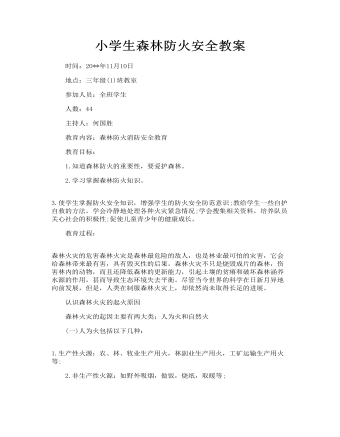
小学生森林防火安全教案
1.知道森林防火的重要性,要爱护森林。 2.学习掌握森林防火知识。 3.使学生掌握防火安全知识,增强学生的防火安全防范意识;教给学生一些自护自救的方法,学会冷静地处理各种火灾紧急情况;学会搜集相关资料,培养队员关心社会的积极性;促使儿童青少年的健康成长。
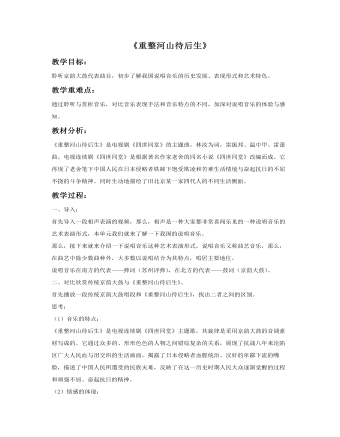
《重整河山待后生》教案
教学过程:一、导入:首先导入一段相声表演的视频,那么,相声是一种大家都非常喜闻乐见的一种说唱音乐的艺术表演形式,本单元我们就来了解一下我国的说唱音乐。那么,接下来就来介绍一下说唱音乐这种艺术表演形式。说唱音乐又称曲艺音乐,那么,在曲艺中除少数曲种外,大多数以说唱结合为其特点,唱居主要地位。说唱音乐在南方的代表——弹词(苏州评弹),在北方的代表——鼓词(京韵大鼓)。二、对比欣赏传统京韵大鼓与《重整河山待后生》。首先播放一段传统京韵大鼓唱段和《重整河山待后生》,找出二者之间的区别。思考:(1)音乐的特点:《重整河山待后生》是电视连续剧《四世同堂》主题歌,其旋律是采用京韵大鼓的音调素材写成的。它通过众多的、形形色色的人物之间错综复杂的关系,展现了抗战八年来沦陷区广大人民血与泪交织的生活画面,揭露了日本侵略者血腥统治、汉奸的卑鄙下流的嘴脸,描述了中国人民所遭受的民族灾难,反映了在这一历史时期人民大众逐渐觉醒的过程和顽强不屈、奋起抗日的精神。(2)情感的体现:《重整河山待后生》这个唱段,表现了抗日战争时期沦陷区人民的苦难,歌颂了中国人民为雪国耻不怕流血牺牲、大义凛然、坚强不屈的民族精神。艺术家骆玉笙在演唱时,发挥了她音域宽阔、抒情色彩浓郁的演唱风格,并揉进了悲壮苍凉的演唱特点。强化了悲壮的、大义凛然、坚强不屈的音乐情绪。
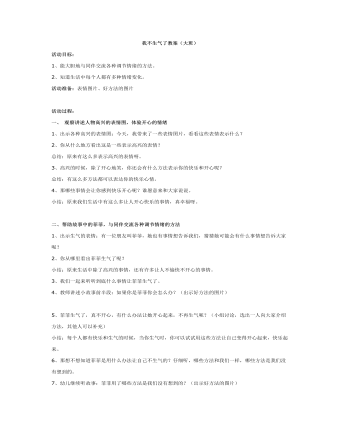
我不生气了教案(大班)
活动过程:一、观察讲述人物高兴的表情图,体验开心的情绪1、出示各种高兴的表情图:今天,我带来了一些表情图片,看看这些表情表示什么?2、你从什么地方看出这是一些表示高兴的表情?总结:原来有这么多表示高兴的表情呀。3、高兴的时候,除了开心地笑,你还会有什么方法表示你的快乐和开心呢?总结:有这么多方法都可以表达你的快乐心情。4、那哪些事情会让你感到快乐开心呢?谁愿意来和大家说说。小结:原来我们生活中有这么多让人开心快乐的事情,真幸福呀。
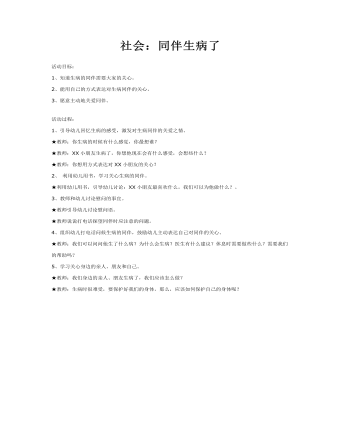
大班社会教案:同伴生病了
活动过程:1、引导幼儿回忆生病的感受,激发对生病同伴的关爱之情。★教师:你生病的时候有什么感觉,你最想谁?★教师:XX小朋友生病了,你想他现在会有什么感受,会想些什么?★教师:你想用方式表达对XX小朋友的关心?2、利用幼儿用书,学习关心生病的同伴。★利用幼儿用书,引导幼儿讨论:XX小朋友最喜欢什么,我们可以为他做什么?。
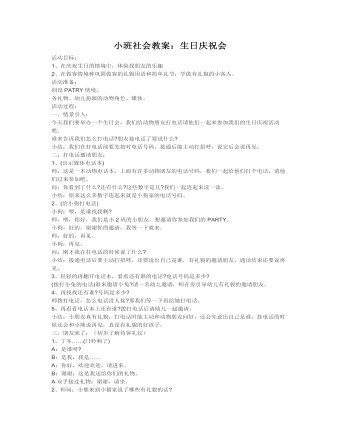
小班社会教案:生日庆祝会
2、在做客情境种巩固做客的礼貌用语和简单礼节,学做有礼貌的小客人。活动准备:创设PATRY情境。 各礼物、幼儿扮演的动物角色、媒体。活动过程:一、情景引入:今天我们要举办一个生日会,我们给动物朋友打电话请他们一起来参加我们的生日庆祝活动吧。谁来告诉我们怎么打电话?朋友接电话了要说什么?小结:我们在打电话前要先按对电话号码,接通后能主动打招呼,说完后会说再见。二:打电话邀请朋友:1、(出示媒体电话本) 师:这是一本动物电话本,上面有许多动物朋友的电话号码,我们一起给他们打个电话,请他们过来参加吧。问:你看到了什么?还有什么?这些数字是几?我们一起连起来读一读。小结:原来这么多数字连起来就是小狗家的电话号码。
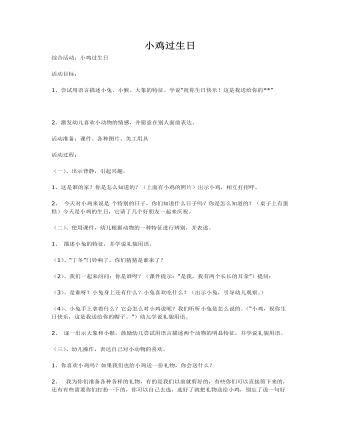
小鸡过生日课件教案
2、激发幼儿喜欢小动物的情感,并愿意在别人面前表达。活动准备:课件、各种图片、美工用具活动过程:(一)、出示背静,引起兴趣。1、这是谁的家?你是怎么知道的?(上面有小鸡的照片)出示小鸡,相互打招呼。2、今天对小鸡来说是 个特别的日子,你们知道什么日子吗?你是怎么知道的?(桌子上有蛋糕)今天是小鸡的生日,它请了几个好朋友一起来庆祝。
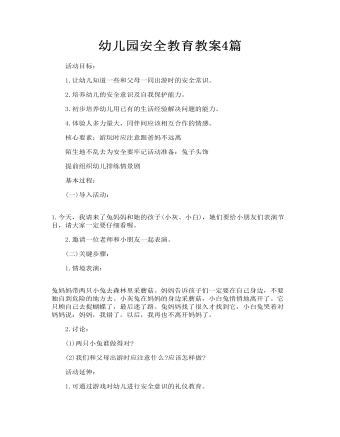
幼儿园安全教育教案4篇
(一)导入活动: 1.今天,我请来了兔妈妈和她的孩子(小灰、小白),她们要给小朋友们表演节目,请大家一定要仔细看喔。 2.邀请一位老师和小朋友一起表演。 (二)关键步骤: 1.情境表演: 兔妈妈带两只小兔去森林里采蘑菇。妈妈告诉孩子们一定要在自己身边,不要独自到危险的地方去。小灰兔在妈妈的身边采蘑菇,小白兔悄悄地离开了。它只顾自己去捉蝴蝶了,最后迷了路。兔妈妈找了很久才找到它,小白兔哭着对妈妈说:妈妈,我错了。以后,我再也不离开妈妈了。
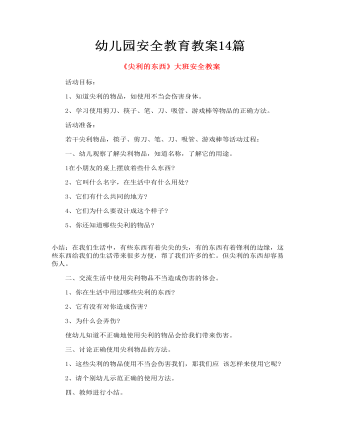
幼儿园安全教育教案14篇
一、幼儿观察了解尖利物品,知道名称,了解它的用途。 1在小朋友的桌上摆放着些什么东西? 2、它叫什么名字,在生活中有什么用处? 3、它们有什么共同的地方? 4、它们为什么要设计成这个样子? 5、你还知道哪些尖利的物品? 小结:在我们生活中,有些东西有着尖尖的头,有的东西有着锋利的边缘,这些东西给我们的生活带来很多方便,帮了我们许多的忙。但尖利的东西却容易伤人。
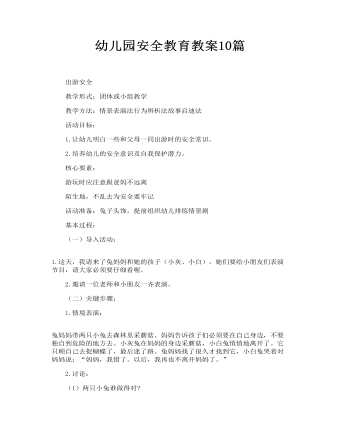
幼儿园安全教育教案10篇
(一)导入活动: 1.这天,我请来了兔妈妈和她的孩子(小灰、小白),她们要给小朋友们表演节目,请大家必须要仔细看喔。 2.邀请一位老师和小朋友一齐表演。 (二)关键步骤: 1.情境表演: 兔妈妈带两只小兔去森林里采蘑菇。妈妈告诉孩子们必须要在自己身边,不要独自到危险的地方去。小灰兔在妈妈的身边采蘑菇,小白兔悄悄地离开了。它只顾自己去捉蝴蝶了,最后迷了路。兔妈妈找了很久才找到它,小白兔哭着对妈妈说:“妈妈,我错了。以后,我再也不离开妈妈了。
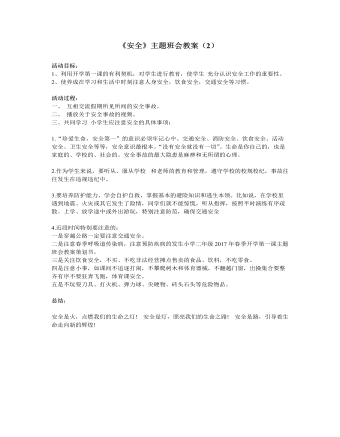
《安全》主题班会教案(2)
活动目标:1、利用开学第一课的有利契机,对学生进行教育,使学生 充分认识安全工作的重要性。2、使养成在学习和生活中时刻注意人身安全,饮食安全,交通安全等习惯。活动过程:一、 互相交流假期所见所闻的安全事故。二、 播放关于安全事故的视频。三、共同学习 小学生应注意安全的具体事项:1.“珍爱生命,安全第一”的意识必须牢记心中。交通安全、消防安全、饮食安全、活动安全、卫生安全等等,安全意识最根本。“没有安全就没有一切”。生命是你自己的,也是家庭的、学校的、社会的。安全事故的最大隐患是麻痹和无所谓的心理。2.作为学生来说,要听从、服从学校 和老师的教育和管理,遵守学校的校规校纪,事故往往发生在违规违纪中。
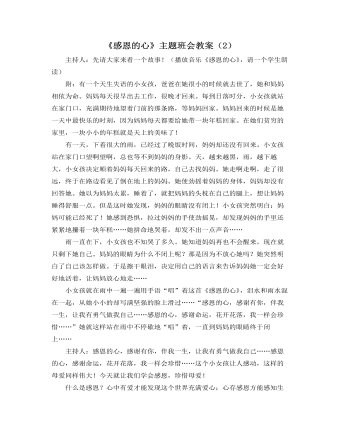
《感恩的心》主题班会教案(2)
服刑的儿子接过这堆葵花子仁,手开始抖。母亲亦无言无语,撩起衣襟拭眼。她千里迢迢探望儿子,卖掉了鸡蛋和小猪崽,还要节省多少开支才凑足路费。来前,在白天的劳碌后,晚上再在煤油灯下嗑瓜子。嗑好的瓜子仁放在一起,看它们像小山一点点增多,没有一粒舍得自己吃。十多斤瓜子嗑亮了许多夜晚。服刑的儿子垂着头。作为身强力壮的小伙子,正应是奉养母亲的时候,他却不能。在所有探监的人当中,他母亲的衣着是最褴褛的。母亲一口一口嗑的瓜子,包含千言万语。儿子“扑通”给母亲跪下,他忏悔了。一次,同龄的朋友对我抱怨起母亲,说她没文化思想不开通,说她什么也干不了还爱唠叨。于是,我就把这两个故事讲给他听。听毕,他泪眼朦胧,半晌无语。

